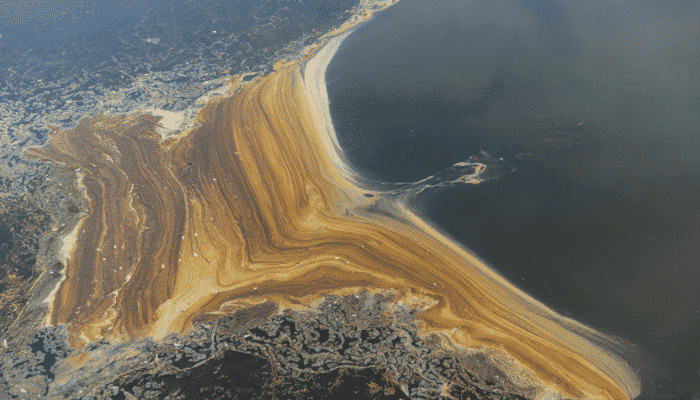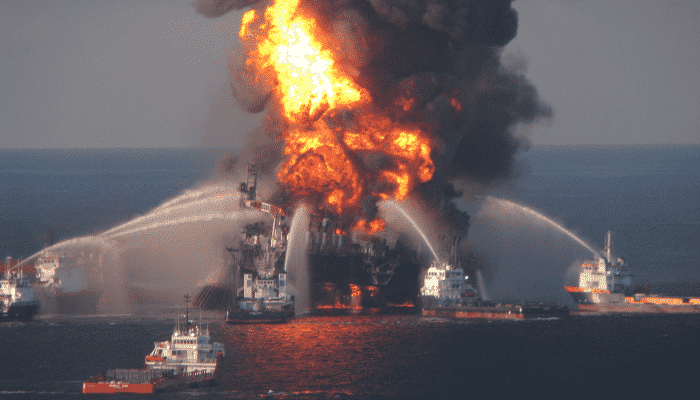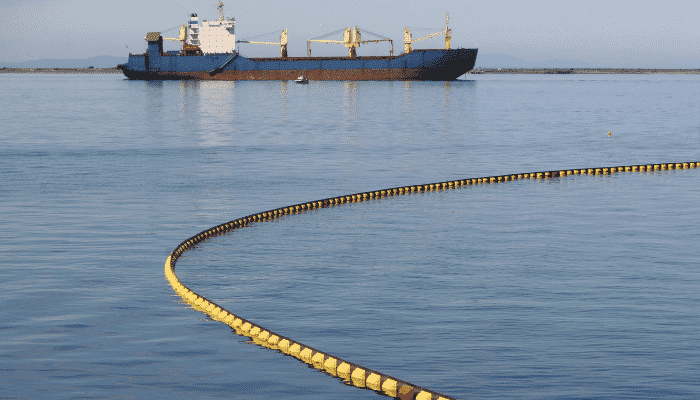What is an Oil Spill at Sea – The Ultimate Guide to Preventing and Cleaning Up

Seawater contamination due to an oil pour due to an accident, explosion, blowout or human error is termed a marine oil spill. These disasters are often a result of human activities, negligence and a lack of effective policy measures.
They can also occur due to natural disasters, such as earthquakes or storms, near an offshore platform or a drilling rig.
Understanding Oil Spills
Oil is among the most important energy sources in the world. Because of its uneven distribution, it is transported by ships across the oceans and by pipelines across the lands. This has resulted in several accidents while transporting the oil to vessels, breaking pipelines, and drilling in the earth’s crust.
While massive and catastrophic spills receive the most attention, smaller and chronic ones occur regularly. These spills contaminate the coasts and estuaries and can cause serious health problems to human beings, not to mention the removal costs.
Oil is a mixture of hydrocarbon compounds, the decayed remains of marine mammals and plants that died and drifted to the bottom. The worst form of pollution affects the coastal waters, harbours and waterways.
Under intense pressure and temperatures for the past 600 million years, these remains changed into complex hydrocarbons called petroleum.
Crude oil is a mixture of gas, naphtha, kerosene, light gas, and residuals, which can cause hazardous health effects if consumed by any life form.
Increased Oil Production And Rise In Oil Spill Accidents
The production of petroleum products rose from 500 million tons in 1950 to over 2,500 million tons in the mid-1990s, which resulted in massive transportation and associated oil spills.
The number has been increasing with the increasing rate of oil transportation, the ageing of oil tankers, and the size of oil tankers. Oil accounts for over half the tonnage of all sea cargo.
Approximately 706 million gallons of oil are estimated to enter the ocean every year, with over half coming from land drainage and waste disposals, such as improperly disposing of used motor oil, gasoline solvents, bunker fuel and diesel fuels.
Offshore drilling and production operations and oil spills or leaks from ships or tankers typically contribute less than 8 percent of the total. The remainder comes from routine ship maintenance (nearly 20 per cent), hydrocarbon particles from onshore air pollution (about 13 per cent), and natural seepage from the seafloor (over 8 per cent).
Health Hazards For Human, Plant And Animal Life
Oil spills kill marine flora and fauna. While dolphins or whales migrate from their areas, small fish, corals, and plants on the ocean floor suffer the most. Also, many seabirds die if their feathers are coated with oil, as they cannot fly and are easily caught by predators. Secondly, oil strips the sea otters’ fur of its natural insulating properties, so they die of hypothermia.
If the oil spill occurs in an area prone to hurricanes, the oil can be blown to land and cause further problems.
Public health impacts include illnesses caused by toxic fumes or eating contaminated fish or shellfish. However, other less apparent public health impacts include losses and disruptions of commercial and recreational fisheries, seaweed harvesting, boating, and other uses of affected water.
Any nation or tourist destination close to oil drilling or shipping lanes is at high risk of experiencing economic collapse and the disastrous environmental effects of oil spills. It needs to be adequately prepared for restoration and cleanup efforts.
Preventing oil spills is the topmost priority, and the responsibility lies equally on individuals, governments, and industries because the sources of oil waste in the ocean are due to carelessness rather than accidents.
A few Precautionary Measures
Integrating preventive measures in an industrial process, operation, or product should be a part of the cost of daily operations.
Before starting any fueling, de-fueling or internal transfer operation, all machinery and piping systems should be adequately checked for tightness and signs of leaking glands, seals and gaskets.
When changing oil or adding oil to machinery, proper care should be taken to avoid oil spills.

Largest Oil Spill
Dreadful oil spills result in significant damage to the marine environment and sometimes end up destroying a complete species.
It is said that the largest known oil spill incident was not an accident but a result of a preplanned war. Statistics show a recorded discharge of billions of gallons of oil from the largest oil spill.
We all are familiar with “the Gulf War” of 1991, in which the forces from Iraq quit their invasion of Kuwait. After that, to block the troops from the United States, the Iraqi forces left the oil pipelines and wells of oil open and set them on fire. The fire was so massive that it began in January and ended after four months in April.
In this incident, as reported, more than 200 million gallons of oil were thrown in “the Persian Gulf”. This oil spill incident harmed not only marine species but also destroyed major oil reserves in the world, thus diminishing oil availability.
The 1989 Exxon Valdez Oil Spill near Prince William Sound, Alaska and the Deepwater Horizon oil spill in the Gulf of Mexico are the most disastrous oil spills in the history of humankind. After these incidents, many laws were introduced, such as the 1990 Oil Pollution Act in the US and the formation of an Office of Response. The Coast Guard and the National Oceanic and Atmospheric Administration handle oil spills in territorial waters and ports in the US.
This oil spill not only resulted in marine water pollution but also fouled the coastlines, damaged the fisheries, killed the aquatic life, especially non-mobile life and ruined the aesthetics of the place, thus reducing the capital generation from tourism.
It had a long-lasting effect on the marine life of the area. The after-effects of this oil spill were even more terrific, as it took months to clear the affected area and bring it back to its normal condition. The destruction caused by this oil spill became a burning issue and a matter of grave concern for almost all the countries around the globe.
Based on the outcomes and reasons for these incidents, maritime authorities are becoming more careful in handling oil, using the latest technical advancements.
Related Reading:
Oil Spill Drills On Ship
It is generally referred to as fighting Oil Spills on Ships. The ship should be equipped with all required preventive measures, and the vessel crew should be accustomed to oil spill safety drills before the voyage. These safety measures will help cater to accidents that break in during the journey without any prior warning.
Before preparing to prevent oil spills or fight oil spillage, it is essential to know about different types of oil spillage.
These accidents are of two types – in one, oil does not go overboard, and in the other, oil goes on board.
The latter causes maximum damage, so it is considered a dreadful incident compared to the former.
There are two most common reasons for oil spills, which are as follows:
- Oil can spill when oil is being transferred internally, that is when oil is passing through a sounding pipe or oil vents
- Bunker operation is the second major event when oil can spill. This implies that there is a higher probability of oil spill while discharging sludge.
If appropriate equipment is used and the personnel is trained in this concern, we can control marine pollution to a certain extent. For less dangerous events, this marine pollution can be avoided entirely.
Basic training is given to the crew during any oil spill drill:
The basic actions to be followed and checked during any oil spill drill are summed up below:
- The side scuppers of the ship should be shut down immediately when any oil is seen on deck. Turn the alarm on and bring it to the notice of the duty officer.
- The points such as the sounding point or vents where the spillage started should be located and must be looked for its solution. All oil transfer processes should also be removed from these points or tanks.
- Muster list should be prepared in advance, and all personnel should be trained for handling spillage. The shipmaster should call the emergency muster when they notice any spill.
- The ship should be equipped with SOPEP equipment that can contain the spill. After collecting all the spilt oil in SOPEP drums, clear the affected area at the earliest.
- Tanks should be filled within permissible levels to avoid spills
- Scupper plug should be tightened appropriately, and sometimes sawdust supplements the tightness of the plug. This will not let the oil rush overboard but act as an additional barrier.
- After fighting victoriously from the incident of an oil spill, a report should be prepared and discussed in a meeting, and preventive measures should be detailed in the meeting to fight and prevent such an incident in future
Additional training on oil spills during sludge discharge or bunkering covers the below checks and actions to be taken:
- The bunkering manifold should have a supervising officer to check it for leakage intermittently at short regular intervals. There should be a remote switch which can send an alarm to STOP BUNKER SUPPLY. Put off the sludge transfer operation with immediate effect
- Bring oil spillage to the notice of the Chief Engineer and the officer on duty
- The drip tray should be checked regularly for overfilling
- Portable foam firefighters should be made available for any discrepancy in case it occurs
Solutions For Oil Spill
The biggest threat to the safe marine environment is the “oil spills” from ships.
Every year, the governments of different countries spend dollars, billions, and trillions inspecting and clearing major oil spills from tanker ships.
Oil spill problems can be prevented at a preliminary stage by ensuring proper operation of all active hoses and fuel lines and that all connections are leak-proof or tight.
All the safety valves should be in proper working condition so the supply line that leaks can immediately be shut off when a spill or leak occurs.
Oil tankers are not cleaned after every voyage; they are cleaned once a decade or when there is clogging or other operational issues.
If sludge or water are buildup in the tanker or are deposited there, they should be cleaned immediately. Otherwise, corrosion of tanker parts or the body may result.
Prevention For Oil Spill
Sometimes, even oil spills on small ships add up to a considerable quantity. These fishing vessels, ferries or recreational boats are comparatively smaller but are a major cause of pollution.
Spills in small vessels are mainly a result of refuelling activity or bilge discharging operation. During these operations, oil mounts up with water in the bottom part of the vessel and gets pumped out.
The following measures can prevent oil spills:
- The crew should ensure that engine bolts are tight to avert oil trickling. When an engine is in use, this causes vibration in bolts and the loosening of bolts. The engine should have a dripping pan, cookie sheet (or oil tray).
- There should be ample oil-absorbing pads to soak up oily water discharge. Defected parts and fittings should be replaced before they completely fail. Lines can fail due to severe heat and water exposures.
- Measures should be taken while refuelling the tank. The tank should not be overfilled; some clearance space should be left for fuel expansion. The bilge pump should be turned off properly after refuelling.
- If a spill occurs, the vessel master should maintain it. He/she should collect the spill to keep it within the ship and clear the affected area with absorbent pads. A record should be maintained regarding the spill, and all legal post-spill formalities should be removed.
Methods For Cleaning Sea After Oil Spill
Oil is necessary and a primary revenue-generating resource for many countries with vast oil reserves. Therefore, shipping oil from the sea can never end; instead, we must look for safer expeditions. We must be ready for any emergency related to an oil spill and oil cleanup from the sea.
As water is denser than oil, the latter floats when discharged into a water body. It forms a skimming layer over the water, making decanting oil from the sea easier than other chemical pollutants.
Different methods of cleaning the sea after an oil spill are listed as under:
1. Oil Booms
Oil Booms are the most common and popular equipment used in oil cleanup due to their more straightforward design and effortless execution. These are also called “Containment Booms”, which enclose the oil to a smaller area and do not let it spread further.

They have three parts: Freeboard, Skirt, and Cable or Chain.
Freeboard is the portion extended beyond the water surface and thwarts splashing oil above the top.
The skirt is positioned down the water surface, squeezes the oil under the boom, and does not let it escape. A spA cable or chain is provided for the ford.
This is for stabilization and strengthening of the vided until it is filled.
Other features of oil booms are as follows:
- This method is employed when the area of spill is comparatively smaller
- It is used where the containment booms are locally available because if the boom is to be transported from a faraway site, the spill can expand to a larger area and become challenging to manage
- Also, it is used in the water where wave velocity is constant because fluctuating tides make it difficult for an oil boom to perform cleanup properly
2. Skimmers
Once oil booms bound the oil, it can be extracted or skimmed easily with the help of skimmers or oil scoops. These skimmers are fitted onto boats to remove floating oil or greasy contaminants.
This mechanical equipment works on the same principle as a vacuum cleaner. It sucks all the oil spread over the confined surface of the water in oil booms.
These use the physical separation of oil and water, making it available for further use. Other prominent features of skimmers are as follows:
- It is an economical method of oil cleanup because the equipment used for skimming oil is relatively cheaper.
- A significant loophole in using a skimmer in oil decantation is that if debris is present in the confined region, it can easily choke or clog the skimmer.
3. Sorbents
The materials which can adsorb or absorb the liquid are termed sorbents. It is an easy process of oil cleanup. We are familiar with sorbents, peat moss, vermiculite (straw), and hay.
Some other features of sorbents are as follows:
- These are the materials which result in the least wastage and prevent the progression of pollution
- These are highly useful for small spills with the highest efficiency
- These are also used to remove the slight tints of large spill cleanups
- There is also a difficulty in working with sorbents that are sorbents become denser than water after absorbing oil and may sink to the bottom of the sea
4. Burning
It is similar to burning rice husks after yielding rice crops. In this method, the floating oil is set to fire by igniting it safely. It is the most proficient method of oil cleanup as it can efficiently remove 98% of total spilt oil.
Other features of burning the spilt oil are briefed as follows:
- It works safely and efficiently for the oil spread with a thickness of 3 millimetres and a more extensive spread
- This method is not eco-friendly as it releases toxic gases from the burning of oils into the environment
5. Dispersants
When oil cannot be confined with booms, we are left with the last option of disintegration. Dispersals are the chemicals spread over spilt oil to initiate the disintegration of oil.
After disintegration, the surface area of oil molecules increases, making it easier for them to bond with water. This will take the bonded molecules more deeply into the water and make them available for microbes that degrade them later.
Some additional features of the removal of oil from the sea by dispersants are as follows:
- They can easily remove large oil spills. Dispersants convert the oil into tarballs when oil gets bonded chemically with water. But sometimes, these tarballs become larger and get to the seashore
- Sometimes, these chemical dispersants adversely affect non-mobile marine species
6. Other Methods
Some other methods employed for safer oil spill cleanups from the sea are hot water washing or washing with high-pressure water, manual labour, bioremediation, and natural recovery.
With high-pressure sprayers, water at about 170-degree Celsius is sprayed. This hot water flushes the oil to the water’s surface at high pressure and makes it available for mechanical equipment such as booms, shovels and skimmers.
Hand-held tools or mechanical equipment are used in manual labour oil cleanup. This method is time-consuming but economical for decanting oil from the sea shoreline. Also, where other methods seem inaccessible, this method serves victoriously.
The bioremediation method involves removing oils by applying specific microorganisms. These microorganisms disintegrate the oil complex into simpler molecules, making decomposition and cleaning easier.
Sometimes fertilizers are used to degrade the oil, which may result in other harm to the marine ecosystem. Natural recovery is the simplest and no-harmful effect method of oil spill cleanups.
The primary principle underlying this method is rivers’ self-cleansing action, which leads to the auto removal of oil by evaporation or natural disintegration by aerobic or anaerobic biological organisms.
It is the most eco-friendly and cheaper method. It is also the most time-consuming process and is usually employed for small oil spills.
You may also like to read:
- Fighting Oil Spill on Ship
- 9 Methods for Oil Spill Cleanup at Sea
- How to Avoid Oil Pollution From Ships?
- Double Inverted Funnel for Intervention on Shipwrecks (DIFIS): A System To Fight Oil Spills from Shipwrecks
- Unique Oil Containment Method: How Air Bubbles can be used to Contain Oil Spills?
Disclaimer: The author’s views expressed in this article do not necessarily reflect the views of Marine Insight. Data and charts, if used, in the article have been sourced from available information and have not been authenticated by any statutory authority. The author and Marine Insight do not claim it to be accurate nor accept any responsibility for the same. The views constitute only the opinions and do not constitute any guidelines or recommendations on any course of action to be followed by the reader.
The article or images cannot be reproduced, copied, shared or used in any form without the permission of the author and Marine Insight.

About Author
Raunek Kantharia is a marine engineer turned maritime writer and entrepreneur. After a brief stint at the sea, he founded Marine Insight in 2010. Apart from managing Marine Insight, he also writes for a number of maritime magazines and websites.
Do you have info to share with us ? Suggest a correction
Subscribe To Our Newsletters
By subscribing, you agree to our Privacy Policy and may receive occasional deal communications; you can unsubscribe anytime.




What are oil spills and how do they affect marine life?
how can we stop oil spills
@Savana: These posts will help – https://www.marineinsight.com/search-results/?q=oil+spill
Very helpful!
????
The article explains the oil clean up procedure, but doe’s not explain the steps to clean up a large Bitumen spill in a ocean environment, I would like to see this question answered in some depth.